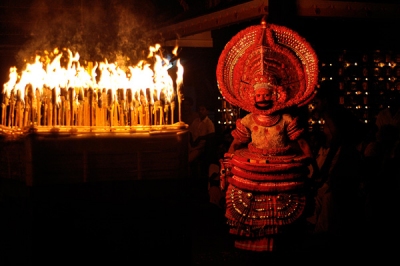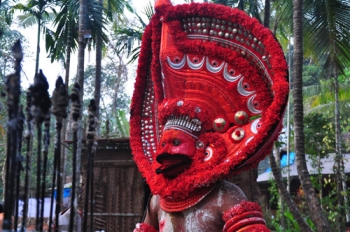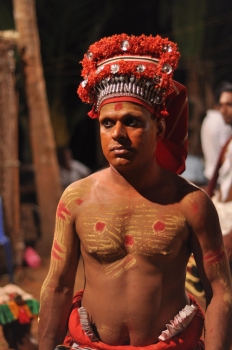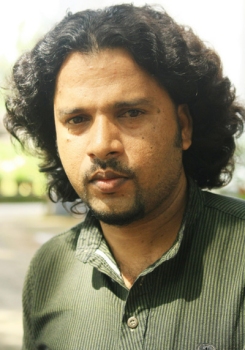
|   |

|   |
Daivakkaru - Padma Jayaraj, Thrissur e-mail: padmajayaraj@gmail.com Photos: Amir Ali February 11, 2012 Daivakkaru is translated as ‘the memoir of a tragic god.’ Here is the story of a man on whom the mantle of divinity falls owing to unusual circumstances of his life and death. Archetypal in dimension, the legend of Mannappan who becomes a god, evokes the poignant tale of Kovalan and Kannagi, the theme of many old world art forms. Popularly known as Kathivanoor Veeran, it is the subject of many literary pieces in Kerala because of its roots in its folklore. His life story has fired the imagination of many artists. It was the stuff of a recent award winning drama in Malayalam that wove modern problems of migration into its theme. ‘Daivakkaru,’ a documentary on a Theyyam performance, featured as part of the Annual International Film Festival in Kerala was something special. Theyyam is a folk performance very popular in northern parts of Kerala. Folk art, all over the subcontinent is intimately connected with myth and mythology. Theyyam springs from oral literature of prehistoric times, known as Thottam paattu (song in praise). Local legends, sung in a special language, recreate the times of ancestral worship and hero worship, along with devotion to Mother Goddess. The hero of the song comes in the guise of the performer. Super human in proportions, divine in dimension, Theyyam has a larger than life role to play even today. Both the native and a visitor to the region feel awestruck by Theyyam. More than two hundred characters don the mantle of Theyyam in Malabar after the harvest season year after year. The society is no longer agrarian now, but Theyyam is the cultural expression of rural Malabar. The visual extravaganza, accompanied by drama, spectacle, music and dance is becalmed in its age old splendor. Folk in essence, there is no room for improvement. Indeed the later day fine arts of Kerala that has risen to classical status owe much to this folk art.  Artiste Aneesh Peruvannan  Theyyam (hero)  Thottam (the singer)  Director VK Anil Kumar The documentary presents the two parts of a Theyyam performance, which deals with the tragic tale of an exceptional man who rises to divine dimensions. The singing part, sung to the accompaniment of percussions, narrates the poignant tale of a rebel who meets with tragic death. Mannappan rebels against caste norms to learn arts of war. Rebelling against an unforgiving father he starts a wanderer’s life. Betrayed by friends he is forced to travel alone in search of his maternal uncle. All the landmarks that the song celebrates are still part of the locale giving it the immediacy of local history and the tone and tenor of an intimate story. At his uncle’s, he proves himself to be a successful farmer. Different types of plantains known and heard in those parts are mentioned. The desire to make some money makes Mannappan go to the market. On his way back, he is wooed by a fatal attraction. Once again, he breaks the caste norms to marry Chemmaruthy, a woman of lower caste. Though he settles down to an indolent life, the woman is a hard bargainer. Here, he proves himself to be a successful merchant. He spends money to buy some arms, since those were the days of attack from the neighboring hills of Coorg. Unfortunately, he was not able to reach home before sunset. In the early hours of the dawn he reaches home to meet an unrelenting jealous wife. The quarrel scene evokes everyday human situation and the patience and nobility of Mannappan. Before the hungry man could eat anything, a battle cry rouses him and after a pitch battle, he returns victorious. On the way he finds blood dripping from his hand where his little finger is missing. His wife might taunt him again. In a fit, he rushes to the battle field where he is trapped and killed. Hearing the story, his wife runs to the burial ground. She sees a star in the sky and jumps into the pyre. The tragic tale of the couple ends here. The Theyyam performance concentrates on the superhuman part of the story. The dead hero comes home to his people. Divine in proportion, Theyyam is a god. The masked performer, grand in stature, dramatizes the milestones of the hero’s journey on earth. A colorful musical show with raging flames in the dead of night is indeed a spectacle. His woman is represented in the form of a small home made in plantain stem and of burning torches. His friends who betrayed him while alive come back to him after death. An ill-fated tale speaks of human values: friendship and love beyond jealousies and betrayals. It also highlights the many facets of the hero. The third part of the documentary speaks of the surprising turn in the story, the transformation of the dead hero in modern times. The performer himself says how performing this particular Theyyam has given him boons, fulfilled his cherished wishes. And people who spend money for a Theyyam performance of Kathivannoor Veeran are also blessed with the fulfillment of their dreams and achievements. Grateful devotees thank the Theyyam performer with tear filled, downcast eyes. Indeed Kathivanoor Veeran is a god, as the word Theyyam suggests in local parlance!! VK Anil Kumar, the director of the documentary who hails from Kannur in Northern Kerala and who works in Sangeetha Nataka Akademi, is passionately devoted to Theyyam. ‘Daivakkaru’ is his second attempt to introduce Theyyam to the world. Padma Jayaraj is a freelance writer and a regular contributor to www.narthaki.com |